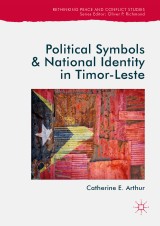Details

Political Symbols and National Identity in Timor-Leste
Rethinking Peace and Conflict Studies
|
74,89 € |
|
| Verlag: | Palgrave Macmillan |
| Format: | |
| Veröffentl.: | 14.09.2018 |
| ISBN/EAN: | 9783319987828 |
| Sprache: | englisch |
Dieses eBook enthält ein Wasserzeichen.
Beschreibungen
This book explores how national identity has been negotiated and (re)imagined through the political symbols that embody it in post-conflict Timor-Leste. It develops a Modernist approach to nations and nationalism by incorporating Bourdieusian theories of symbolic capital and conflict, to examine how national identity has been constructed and represented in political symbols. Taking case studies of flags, monuments, national heroes, and street art, it critically analyses how a diverse population has interpreted and (re)constructed its national identity throughout the first decade of independence, and how the transition from a context of conflict to peace has influenced such popular imaginings. By examining these processes of identification with a wide range of symbols, the book discusses the numerous challenges that this young nation-state still faces, including victimhood and recognition, democratization and electoral politics, the political role of cosmology and spirituality, and post-colonial generational differences and divisions.
<div>Chapter One: Introduction: Struggle, suffering and symbols: Narratives of nationalism and representing identity.- Chapter Two: Flying the nation’s colours: Commemorations of the past and the national flag of Timor-Leste.- Chapter Three: Monuments and memorials: Funu, terus and constructing an East Timorese national identity.- Chapter Four: The Spirit of Rebellion: National heroes, Dom Boaventura, and Personifying National Identity in Timor-Leste.- Chapter Five: ‘Big Brother Xanana’: The cult of personality and the creation of a contemporary national hero.- Chapter Six: The Struggle Continues: Peace and prosperity, democratic values and development in political party flags.- Chapter Seven: Painting Peace and Prosperity: Street art, the Geração Foun, and identifying with an evolving ‘East Timorese-ness’.- Chapter Eight: Conclusion.</div>
Catherine Arthur's research on post-conflict nation-building, identity politics, and symbols particularly focuses on Timor-Leste as a transitional society.
This book explores how national identity has been negotiated and (re)imagined through the political symbols that embody it in post-conflict Timor-Leste. It develops a Modernist approach to nations and nationalism by incorporating Bourdieusian theories of symbolic capital and conflict, to examine how national identity has been constructed and represented in political symbols. Taking case studies of flags, monuments, national heroes, and street art, it critically analyses how a diverse population has interpreted and (re)constructed its national identity throughout the first decade of independence, and how the transition from a context of conflict to peace has influenced such popular imaginings. By examining these processes of identification with a wide range of symbols, the book discusses the numerous challenges that this young nation-state still faces, including victimhood and recognition, democratization and electoral politics, the political role of cosmology and spirituality, and post-colonial generational differences and divisions.<div><br></div><div>Catherine Arthur is currently an Early Career Researcher. Dr Arthur's research on post-conflict nation-building, identity politics, and symbols particularly focuses on Timor-Leste as a transitional society.</div>
Expands research on nation-building in Timor-Leste, adding a new dimension to studies of national identity Develops theories of national identity, and symbols, offering a more robust theoretical approach by bringing together a range of social science disciplines Examines an often overlooked aspect of post-conflict nation-building in a unique, post-colonial context
Diese Produkte könnten Sie auch interessieren:

Inclusión educativa de niños, niñas y adolescentes migrantes venezolanos, en Colombia

von: Douglas Jiménez

15,99 €
















